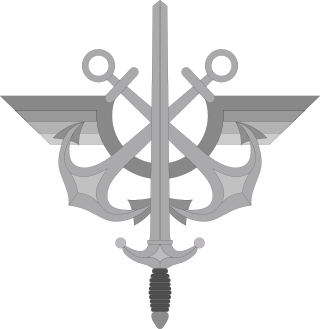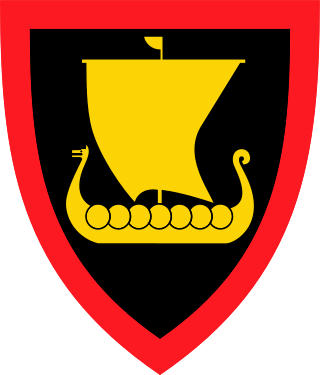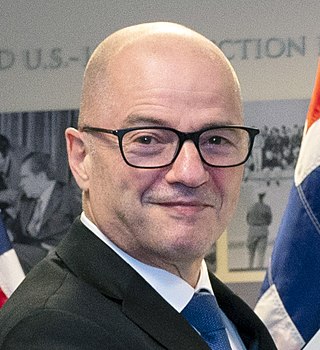
The French Armed Forces are the military forces of France. The armed forces consists of four military branches: the Army, Navy, Air and Space Force and the National Gendarmerie. The National Guard serves as the French Armed Forces' military reserve force. As stipulated by France's constitution, the president of France serves as commander-in-chief of the French military. France has the eighth largest defence budget in the world and the second largest in the European Union (EU). It also has the largest military by size in the EU. A 2015 Credit Suisse report ranked the French Armed Forces as the world's sixth-most powerful military.

The North Atlantic Treaty Organization, also called the North Atlantic Alliance, is an intergovernmental military alliance between 31 member states – 29 European and two North American. Established in the aftermath of World War II, the organization implemented the North Atlantic Treaty, signed in Washington, D.C., on 4 April 1949. NATO is a collective security system: its independent member states agree to defend each other against attacks by third parties. During the Cold War, NATO operated as a check on the threat posed by the Soviet Union. The alliance remained in place after the dissolution of the Soviet Union and the Warsaw Pact, and has been involved in military operations in the Balkans, the Middle East, South Asia, and Africa. The organization's motto is animus in consulendo liber.

World War III and the Third World War are names given to a hypothetical worldwide large-scale military conflict subsequent to World War I and World War II. The term has been in use since at least as early as 1941. Some apply it loosely to limited or more minor conflicts such as the Cold War or the war on terror. In contrast, others assume that such a conflict would surpass prior world wars in both scope and destructive impact.

The International Security Assistance Force (ISAF) was a multinational military mission in Afghanistan from 2001 to 2014. It was established by United Nations Security Council Resolution 1386 pursuant to the Bonn Agreement, which outlined the establishment of a permanent Afghan government following the U.S. invasion in October 2001. ISAF's primary goal was to train the Afghan National Security Forces (ANSF) and assist Afghanistan in rebuilding key government institutions; it gradually took part in the broader war in Afghanistan against the Taliban insurgency.

The Norwegian Army is the land warfare service branch of the Norwegian Armed Forces. The Army is the oldest of the Norwegian service branches, established as a modern military organization under the command of the King of Norway in 1628. The Army participated in various continental wars during the 17th, 18th, and 19th centuries as well, both in Norway and abroad, especially in World War II (1939–1945). It constitutes part of the Norwegian military contribution as a charter member of the North Atlantic Treaty Organization (NATO) since 1949.

An EU Battlegroup is a military unit adhering to the Common Security and Defence Policy (CSDP) of the European Union (EU). Often based on contributions from a coalition of member states, each of the eighteen Battlegroups consists of a battalion-sized force reinforced with combat support elements. Two of the battlegroups were declared to be capable of being assembled for operational deployment at any one time.

As of 4 September 2006, there have been 3,502 coalition deaths in Afghanistan as part of ongoing coalition operations since the invasion in 2001. In this total, the American figure is for deaths "In and Around Afghanistan" which, as defined by the United States Department of Defense, includes some deaths in Pakistan and Uzbekistan and the deaths of 18 CIA operatives.

The NATO Response Force (NRF) is a high-readiness NATO rapid deployment force comprising land, sea, air, and special forces units capable of being deployed quickly within short notice. The NRF currently comprises up to 40,000 troops, with plans to increase its manpower to over 300,000 troops. Its forces include units from several non-NATO member partners, including Sweden, Ukraine, and Georgia.

The Telemark Bataljon is a mechanised infantry battalion of the Norwegian Army. It was established in 1993, and is a part of Brigade Nord and stationed at Rena, Hedmark. The battalion consists of five companies/squadrons.

Odd Roger Enoksen is a Norwegian politician representing the Norwegian Centre Party. He served as minister of defence from 2021 to 2022. He was also leader of the Centre Party from 1999 to 2003. Further, he served as minister of local government and deputy to the prime minister from 1999 to 2000, and minister of petroleum and energy from 2005 to 2007.

Exercise Bright Star is a series of biennial combined and joint military exercises led by the United States and Egypt. The exercises began in 1980, rooted in the 1977 Camp David Accords. After its signing, the United States Armed Forces and the Egyptian Armed Forces agreed to conduct training together in Egypt.

In January 2006, NATO's focus in southern Afghanistan was to form Provincial Reconstruction Teams with the British leading in Helmand Province and the Netherlands, Australia and Canada leading similar deployments in Orūzgān Province and Kandahar Province respectively. The United States, with 2,200 troops, stayed in control of Zabul Province. Local Taliban figures voiced opposition to the incoming force and pledged to resist it.
1 German-Netherlands Corps (1GNC) is a multinational formation consisting of units from both the Royal Netherlands Army and German Army. The corps' headquarters also takes part in NATO Response Force readiness rotations. It is situated in Münster, formerly the headquarters of the German Army's I. Corps out of which 1 German-Netherlands Corps evolved. The corps has national and multinational operational responsibilities.

Operation Karez was a military operation between May 13–23, 2008 involving Norwegian and German ISAF and Afghan government forces against the Taliban as part of the war in Afghanistan. Their objective was to eliminate the presence of Taliban insurgents who had regrouped in the area in the aftermath of Operation Harekate Yolo in late 2007.

Loyal Arrow was a major exercise of the North Atlantic Treaty Organization (NATO) held in Northern Sweden on 8 June 2009 – 16 June 2009. Ten NATO and non-NATO countries will participate in the live fire exercises, which is aimed to train selected parts of the NATO Response Force Joint Force Air Component Headquarters in the conduct and coordination of air operations.

Enhanced Forward Presence (EFP) is a NATO-allied forward-deployed defense and deterrence military force in Northern, Central and Eastern Europe. This posture in Northern Europe through Estonia, Latvia, and Lithuania and in Central Europe through Poland, Slovakia and Hungary and in Eastern Europe through Romania and Bulgaria, is in place to protect and reassure the security of NATO's Northern, Central and Eastern European member states on NATO's eastern flank.

This article outlines the defence forces of the European Union (EU), which implement the EU's Common Security and Defence Policy (CSDP) in CSDP missions. There are two categories of EU multinational forces: ones that have been established intergovernmentally and made available to the CSDP through article 42.3 of the Treaty on European Union (TEU), such as the Eurocorps; and the EU Battlegroups, established at the EU level.

Trident Juncture 18, abbreviated TRJE18, was a NATO-led military exercise held in Norway in October and November 2018 with an Article 5 collective defence scenario. The exercise was the largest of its kind in Norway since the 1980s. An expected 50,000 participants from 31 nations partook, including 10,000 vehicles, 250 aircraft and 65 vessels. The exercise was mainly held in the central and eastern parts of Norway, in addition to air and sea areas in Norway, Sweden and Finland. The stated goal of Trident Juncture was to train the NATO Response Force and to test the alliance's defence capability. According to the Norwegian Armed Forces, the exercise tested the country's ability to receive and handle allied support.

Armed forces play a crucial role when responding to crises and emergencies. In response to the COVID-19 pandemic, militaries were readily deployed in many countries to assist the civilian medical personnel and overwhelmed hospitals by creating additional hospitals and providing other additional resources. Apart from the management of the health crises, the pandemic has had a significant impact on the military operations. The security and defence related aspects including the missions, operations and training were adversely affected with the Covid-19. The broad spread of Covid can limit the defence forces' ability to carry out a mission. Many military training and exercises have been postponed or cancelled.



















